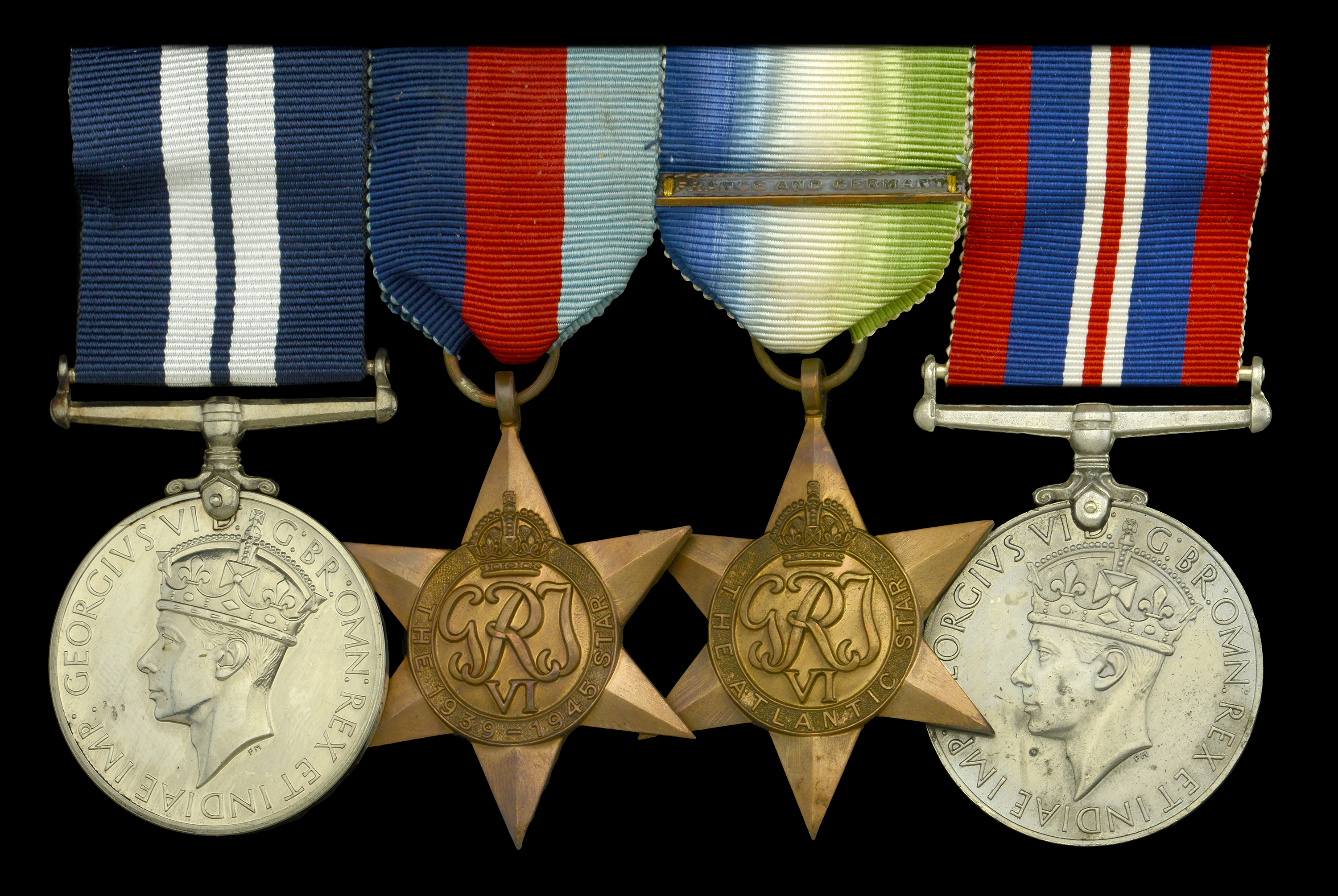37
A fine Second War Coastal Forces D.S.M. group of four awarded to Acting Leading Stoker R....
Gebote sind ohne Steuern, Aufgeld oder Versankosten.
By confirming your bid, you agree that you have read and accepted the-saleroom.com and the auctioneer's terms and conditions. Confirming your bid is a legally binding obligation to purchase and pay for the lot should your bid be successful.
Wählen Sie eine der folgenden Schnellgebotsoptionen:
Gebote sind ohne Steuern, Aufgeld oder Versankosten.
By confirming your bid, you agree that you have read and accepted the-saleroom.com and the auctioneer's terms and conditions. Confirming your bid is a legally binding obligation to purchase and pay for the lot should your bid be successful.
Distinguished Service Medal, G.VI.R. (A./Ldg. Sto. R. W. Muir D/KX. 92804) officially engraved naming; 1939-45 Star; Atlantic Star, 1 clasp, France and Germany; War Medal 1939-45, extremely fine (4) £1,200-£1,600
---
Importation Duty
This lot is subject to importation duty of 5% on the hammer price unless exported outside the UK
---
---
Provenance: Spink, April 1999.
D.S.M. London Gazette 11 September 1945:
‘For courage and skill in H.M. S.G.B. No. 7 in a daring attack on a heavily screened enemy merchant vessel carried out on the night of 18-19 June 1942, in company with H.M.S. Albrighton and H.M. S.G.B. No. 8.’
The original recommendation states: ‘Acting Leading Stoker Muir was in charge of the Boiler Room during the action, replied calmly to all my questions when I went down to see the extent of the damage and carried out his duties until the end. He never mentioned the fact that he had from the beginning of the action a severe wound in his stomach, a fact I only learnt later when I was told he had been sent to a German hospital, where he stayed for many weeks.’
Robert Watt Muir was born in Cape Town, South Africa and joined the Royal Navy in December 1937.
One of three crew members from H.M. Steam Gun Boat No. 7 to receive the D.S.M. for this action in the Baie De La Seine, his C.O., Lieutenant R. L. Barnet, being mentioned in despatches but as a French national his award was never gazetted. In his official post-war report describing the loss of S.G.B. No. 7, Barnet describes how he carried out a successful torpedo strike on an enemy merchantman - ‘which sank the following morning’ - prior to setting course for home waters:
‘On the way back S.G.B. No. 7 met two German escort vessels with whom a hot engagement took place at very close range. In the course of this engagement one of the escort vessels was hit repeatedly by S.G.B. No. 7’s after gun and left in a sinking condition. The second German escort vessel was seen to be damaged but escaped and unfortunately managed to damage so heavily S.G.B. No. 7’s boiler that further steaming was then impossible. When dawn broke and no further hope of being rescued by our own forces could be entertained, I ordered the ship to be scuttled as German ships were approaching to make an attempt at boarding. By that time none of our weapons were in working condition. The crew was ordered to abandon ship and was shortly after rescued and taken prisoner by German R-boats’ (TNA ADM1/30420 refers).
Muir was admitted to hospital in Cherbourg and thence, in July 1942, to Stalag 133 at Rennes, where he was interrogated by six German officers with rapid-fire questions; his P.O.W. debrief further reveals that he was subsequently held in solitary confinement in Wilhelmshaven, where he was again interrogated. Finally, in September 1942, he was transferred to Marlag und Milag Nord at Westmertimke (Tarnstedt), from which he was liberated by the Allies in April 1945.
The Steam Gun Boats
Built as an experiment to maximise fire-power in the violent encounters that became Coastal Forces’ brief, Steam Gun Boats quickly won fame for pressing home the attack whatever the odds, Lieutenant Barnet’s and Muir’s encounter on the night of 18-19 June 1942 being a case in point. Just seven S.G.B.s were completed, between February and July 1942, further production being halted in favour of freeing up the slipways for destroyers.
The boats were heavily armed much respected by enemy E- and R-boats: by 1944, S.G.B.s boasted a 6-pounder, power-mounted gun forward, a 3-inch hand operated gun aft, four sets of 20mm. twin-Oerlikon guns (either side of the bridge and aft), six sets of twin-Vickers .303 machine-guns (pairs on the bridge, below the bridge and by the torpedo tubes), two 21-inch torpedoes, and four depth-charges for good measure – and were still capable of a maximum speed of 30 knots.
As Leonard Reynolds concludes in his Dog Boats at War, S.G.B.s were involved in numerous actions that indicated ‘an enormous amount of gallantry and of attacks pressed home whatever the odds.’ Casualties in the Flotilla were indeed high, as were the number of decorations awarded to the 30-strong crews.
The Flotilla’s first C.O. was Lieutenant-Commander Peter Scott, M.B.E., D.S.C., son of the famous Antarctic explorer, who was instrumental in getting Admiralty approval for the boats to be named rather than numbered. S.G.B. No. 7, however, did not survive long enough to receive the accolade, and her loss led to additional armour plating being installed in the boats to protect their boilers.
Sold with related King’s ‘Loyal Service’ Badge and campaign award forwarding slip, together with copied research including Admiralty reports referred to above.
Distinguished Service Medal, G.VI.R. (A./Ldg. Sto. R. W. Muir D/KX. 92804) officially engraved naming; 1939-45 Star; Atlantic Star, 1 clasp, France and Germany; War Medal 1939-45, extremely fine (4) £1,200-£1,600
---
Importation Duty
This lot is subject to importation duty of 5% on the hammer price unless exported outside the UK
---
---
Provenance: Spink, April 1999.
D.S.M. London Gazette 11 September 1945:
‘For courage and skill in H.M. S.G.B. No. 7 in a daring attack on a heavily screened enemy merchant vessel carried out on the night of 18-19 June 1942, in company with H.M.S. Albrighton and H.M. S.G.B. No. 8.’
The original recommendation states: ‘Acting Leading Stoker Muir was in charge of the Boiler Room during the action, replied calmly to all my questions when I went down to see the extent of the damage and carried out his duties until the end. He never mentioned the fact that he had from the beginning of the action a severe wound in his stomach, a fact I only learnt later when I was told he had been sent to a German hospital, where he stayed for many weeks.’
Robert Watt Muir was born in Cape Town, South Africa and joined the Royal Navy in December 1937.
One of three crew members from H.M. Steam Gun Boat No. 7 to receive the D.S.M. for this action in the Baie De La Seine, his C.O., Lieutenant R. L. Barnet, being mentioned in despatches but as a French national his award was never gazetted. In his official post-war report describing the loss of S.G.B. No. 7, Barnet describes how he carried out a successful torpedo strike on an enemy merchantman - ‘which sank the following morning’ - prior to setting course for home waters:
‘On the way back S.G.B. No. 7 met two German escort vessels with whom a hot engagement took place at very close range. In the course of this engagement one of the escort vessels was hit repeatedly by S.G.B. No. 7’s after gun and left in a sinking condition. The second German escort vessel was seen to be damaged but escaped and unfortunately managed to damage so heavily S.G.B. No. 7’s boiler that further steaming was then impossible. When dawn broke and no further hope of being rescued by our own forces could be entertained, I ordered the ship to be scuttled as German ships were approaching to make an attempt at boarding. By that time none of our weapons were in working condition. The crew was ordered to abandon ship and was shortly after rescued and taken prisoner by German R-boats’ (TNA ADM1/30420 refers).
Muir was admitted to hospital in Cherbourg and thence, in July 1942, to Stalag 133 at Rennes, where he was interrogated by six German officers with rapid-fire questions; his P.O.W. debrief further reveals that he was subsequently held in solitary confinement in Wilhelmshaven, where he was again interrogated. Finally, in September 1942, he was transferred to Marlag und Milag Nord at Westmertimke (Tarnstedt), from which he was liberated by the Allies in April 1945.
The Steam Gun Boats
Built as an experiment to maximise fire-power in the violent encounters that became Coastal Forces’ brief, Steam Gun Boats quickly won fame for pressing home the attack whatever the odds, Lieutenant Barnet’s and Muir’s encounter on the night of 18-19 June 1942 being a case in point. Just seven S.G.B.s were completed, between February and July 1942, further production being halted in favour of freeing up the slipways for destroyers.
The boats were heavily armed much respected by enemy E- and R-boats: by 1944, S.G.B.s boasted a 6-pounder, power-mounted gun forward, a 3-inch hand operated gun aft, four sets of 20mm. twin-Oerlikon guns (either side of the bridge and aft), six sets of twin-Vickers .303 machine-guns (pairs on the bridge, below the bridge and by the torpedo tubes), two 21-inch torpedoes, and four depth-charges for good measure – and were still capable of a maximum speed of 30 knots.
As Leonard Reynolds concludes in his Dog Boats at War, S.G.B.s were involved in numerous actions that indicated ‘an enormous amount of gallantry and of attacks pressed home whatever the odds.’ Casualties in the Flotilla were indeed high, as were the number of decorations awarded to the 30-strong crews.
The Flotilla’s first C.O. was Lieutenant-Commander Peter Scott, M.B.E., D.S.C., son of the famous Antarctic explorer, who was instrumental in getting Admiralty approval for the boats to be named rather than numbered. S.G.B. No. 7, however, did not survive long enough to receive the accolade, and her loss led to additional armour plating being installed in the boats to protect their boilers.
Sold with related King’s ‘Loyal Service’ Badge and campaign award forwarding slip, together with copied research including Admiralty reports referred to above.
Orders, Decorations, Medals and Militaria
Auktionsdatum
Ort der Versteigerung
Generelle Versandinformationen vom Auktionshaus verfügbar
If you are successful in purchasing lot/s being auctioned by us and opt for the item/s to be sent to you, we will use the following methods of shipment:
Within the UK
If you live within the UK, items will be despatched using Royal Mail Special Delivery. This service provides parcel tracking (via the Royal Mail website) and next weekday delivery (betwen 9am and 1pm). Items delivered within the UK are covered by our insurance company. Heavy and bulky lots will be sent by courier, in discussion with the client.
Outside of the UK
If the item/s being sent are worth under £1000 in total they are sent using Royal Mail’s Signed For International service. This ensures the item must be signed for when it is delivered.
If the item/s being sent are valued at over £1000 in total they will be sent using FedEx. This service allows next day delivery to customers in many parts of the US and parcels are fully trackable using the FedEx website.
Shipping Exceptions
Certain lots such as those containing glass or sharp implements, etc., may not be suitable for in-house shipping within or outside of the UK. Please contact Noonans with any queries.
Wichtige Informationen
Auctioneer's Buyers Premium: 24% (+VAT)
There is an additional charge of 4.95% (+VAT/sales tax)










